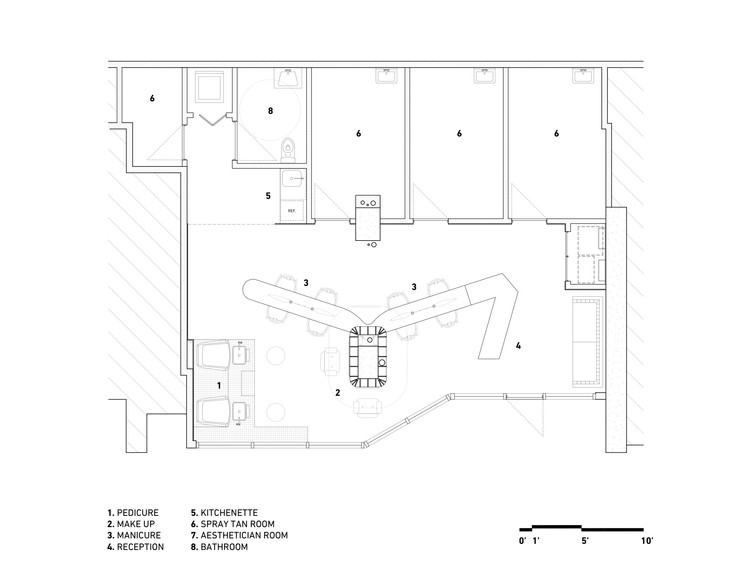AD Classics Caja Granada Savings Bank Alberto Campo Baeza
2015-03-05 09:00
与坎波巴扎的许多项目一样,卡贾格拉纳达是一项精确和控制的练习,在这一过程中,综合设计非常清晰地驯服了自然和人为的元素。复杂但不复杂,其欺骗性极简主义的贫困仍然是感官的盛宴,是坎波巴扎的个人光辉的缩影,其戏剧性的轻描淡写。
Like many of Campo Baeza’s projects, the Caja Granada is an exercise in precision and control, in which the totalizing design tames elements both natural and manmade with exceptional clarity. Sophisticated but not fussy, complex but not complicated, its deceptively minimalist poverty is yet a feast for the senses, the epitome of Campo Baeza’s personal flare for the drama of understatement.
© Estudio Arquitectura Campo Baeza
c Estudio ArquArchtura Campo Baeza
该项目的建筑主体位于一个巨大的、人造的基座上,就像展台上的雕塑一样,呈立方体状。它原始的线条和严苛的混凝土架子几乎没有传达出西班牙南部建筑的温暖。这是一个外来的建筑,防御工事,在坚固的墙后面退却。但是,即使是在其虔诚和几乎顽固地坚持一个无所不能的网格,它也暴露出一种智力活力,这种活力用人的触觉来调和纯粹的理性,尤其表现在其内部聚集的不对称和不规则性上。
The architectural corpus of the project rests in a cube-like volume that sits atop a massive, artificial plinth—like a sculpture on a display stand. Its pristine lines and regimented concrete shelves convey little of the warmth so typical of the architecture of southern Spain. It is an alien structure, fortified against the outside, retreating into itself behind the solidity of reinforced walls. But even in its devout and almost obstinate adherence to an omnipotent grid, it betrays a intellectual vitality that tempers pure rationality with a human touch, manifested particularly in the asymmetries and irregularities of its interior massing.
Exterior glass on the southern profiles is recessed behind the extruded frame to shield it from direct sunlight. Image © Estudio Arquitectura Campo Baeza
南面轮廓上的外部玻璃是在挤压框后面的凹槽,以保护它免受直接的阳光照射。图像(Estudio ArquArchtura Campo Baeza)
在南面的正面,垂直栅格是通过玻璃墙的挤压来表现出来的,在玻璃墙上,它充当了遮挡室内办公室免受南方严酷阳光照射的巨大太阳。可见的三米矩阵与严格规定内部和外部分区组织的水平网格相同。无缝细木工和精确的排列创造了一个轮廓是如此僵硬的平面,如此没有变化和清晰度,使四边形的壁龛似乎被奇迹般地雕刻成一个单一的整体混凝土块,曾经构成建筑物的原始形式。洞室的浓重阴影只会使窗户的衰退变得更加清晰,变成黑暗。
On the southern facades, the vertical grid finds expression through its extrusion through a glass wall, upon which it acts as a brise soleil that shields the interior offices from the harsh southern sunlight. The visible three-meter matrix is identical to the horizontal grid that rigidly dictates the organization of interior and exterior partitions. Seamless joinery and precise alignment create a profile that is so rigidly planar, so devoid of variation and articulation, that the quadrated niches appear to have been miraculously carved into a single monolithic block of concrete that once constituted the building’s primordial form. The heavy shadows of the cavities only sharpen the strong reading of the windows’ recession into darkness.
Ground Floor Plan. Image © Estudio Arquitectura Campo Baeza
底层平面图图像(Estudio ArquArchtura Campo Baeza)
在分割出的轮廓中,我们发现了一种早期的预感,那就是块内的壮观的裂谷。大楼的核心是一个巨大的中央中庭,通过天窗向太阳开放,将周围办公室的目光倒转到内部的开放空间。这座雄伟的洞穴的地面是设计的核心,是坎波巴扎的建筑戏剧表演的真正舞台。从这个有利的角度来看,结构元素的相互作用-由四根巨大的混凝土柱和无法穿透的石墙毫不费力地支撑在天花板上的坚固线条-正在移动。在这里,建筑师执行几乎不可能的调和清洁,秩序,复杂性,和真正的结构诚实:极简主义,也许,但与人的灵魂。
In the carved-out profile we find an early premonition of the spectacular chasm that lies within the block. A vast, central atrium at the core of the building, opened to the sun by skylight, inverts the gaze of the surrounding offices to the open space within. The floor of this imposing cavern is the heart of the design, the veritable stage upon which Campo Baeza’s architectural drama plays out. From this vantage point, the interplay of structural elements—the strong lines of the ceiling trusses, supported so effortlessly by four mighty, concrete columns and impenetrable walls of stone—is moving. Here the architect executes the near-impossible reconciliation of cleanliness, order, complexity, and genuine structural honesty: minimalism, perhaps, but with a human soul.
Minimal furnishings avoid distrating from the stark barenness of the concrete. Image © Estudio Arquitectura Campo Baeza
最小的陈设避免分散对混凝土严酷的贫瘠的注意力。图像(Estudio ArquArchtura Campo Baeza)
混凝土和大理石墙,坚忍和保留在他们的单色中立,消除了外部和内部的条件区分,并勾结了一个建筑物完全从一个单一的砌块。但在这个空间中,物质的均匀性发现自己受到巨大的大气变化,因为光源和质量的光波动。在更黑暗的时间里,半透明的白色墙从后面隐约发光,被北部的办公室照亮,让人想起邦哈勒图书馆里的大理石面板。在阳光直射的时代,阳光的温暖改变了中庭的面貌,就像一座洞穴般的欧洲大教堂,只有由其牧师稀疏而明亮的窗户点亮。
Walls of concrete and alabaster, stoic and reserved in their monochromatic neutrality, obviate the conditional distinction between exterior and interior and collude with the illusion of a building hewn entirely from a single block. But in this space, material homogeneity finds itself subjected to dramatic atmospheric variation as the sources and qualities of light fluctuate. During darker hours, the semi-translucent alabaster walls glow faintly from behind, illuminated by the northern offices with a striking radiance reminiscent of the marble panels in Bunshaft‘s Beinecke Library. In times of direct daylight, the warmth of sunlight transforms the atrium with all the contrast and spectacle of a cavernous European cathedral lit only by the sparse but brilliant windows of its clerestory.
The transluscent glow of the thin alabaster wall of the northern offices. Image © Estudio Arquitectura Campo Baeza
北方办公室薄的白墙半用的光辉。图像(Estudio ArquArchtura Campo Baeza)
没有哪一家银行比在这个神圣的空间-这座首都大教堂-更接近于上帝了,这座大教堂的焦点似乎正飞向巨大的中央码头,进入光明之中。就像整个中世纪基督世界里刻意追求和复制的感觉一样,这个巨大的提升的内部让游客感到可悲的渺小,仿佛在伟大的存在中使她卑微。
And no closer does a bank come to God than in this sacred space—this cathedral of capital—whose very focus seems to travel skyward up the massive central piers and into the light. Like the sensation deliberately pursued and replicated throughout medieval Christendom, this monumentally upscaled interior makes the individual visitor feel pathetically small, as if to humble her amidst the presence of greatness.
© Estudio Arquitectura Campo Baeza
c Estudio ArquArchtura Campo Baeza
在格拉纳达的建筑文化中,我们应该把这座银行设在哪里呢?这个城市是一个中世纪教堂和宫殿组成的城市,充满了广泛的文化冲动。Campo Baeza作品的特点是,Caja Granada并不是对毫无必要的创造性建筑语言的探索;它是他重新定位和改进现有词汇的能力的产物,它将历史上的光和尺度课程与当今的物质和结构实践结合起来。即使在现代修辞学中,它也不会与欧洲几百年来的设计情怀脱节,因为毫无疑问:这是现代的哥特式建筑,是21世纪经济学家的宗教。
Where are we to locate this bank within Granada’s architectural culture, a city of medieval churches and palaces infused with the impulses of cultures far and wide? Characteristic of Campo Baeza’s work, the Caja Granada isn’t an exploration in needlessly inventive architectural languages; it is the product of his ability to repurpose and improve upon established vocabularies, combining lessons on light and scale from history with material and structural practices of the present day. Even in its modern rhetoric, it suffers no spiritual disconnect with the centuries-old sensibilities of European design, for make no mistake: this is Gothic architecture in modern guise, religion for the twenty-first century economist.
© Estudio Arquitectura Campo Baeza
c Estudio ArquArchtura Campo Baeza
[1]“Caja Granada储蓄银行”。阿奎特图拉·坎波·贝萨(Estudio De Arqucitura Campo Baeza)2015年1月29日查阅:http:/www.campobaeza.com/wp-content/上载/2001/01/2001_CajaGranada_PDF-web.pdf。
[1] “Caja Granada Savings Bank.” Estudio de Arquitectura Campo Baeza. Accessed 29 January 2015 from http://www.campobaeza.com/wp-content/uploads/2001/01/2001_CajaGranada_PDF-web.pdf.
建筑师Alberto Campo Baeza地点Carretera de Motril
Architects Alberto Campo Baeza Location Carretera de Motril & Avenida de la Ciencia, 2 Category Bank Project Year 2001 Photographs Estudio Arquitectura Campo Baeza
 举报
举报
别默默的看了,快登录帮我评论一下吧!:)
注册
登录
更多评论
相关文章
-

描边风设计中,最容易犯的8种问题分析
2018年走过了四分之一,LOGO设计趋势也清晰了LOGO设计
-

描边风设计中,最容易犯的8种问题分析
2018年走过了四分之一,LOGO设计趋势也清晰了LOGO设计
-

描边风设计中,最容易犯的8种问题分析
2018年走过了四分之一,LOGO设计趋势也清晰了LOGO设计
































































